 Our tour guide, a Beijing resident who has about 15 years of experience in the business, could easily rattle off the names of the halls and courts we were in. I certainly cannot. As I look through the photos, I have trouble remembering where is what.
Our tour guide, a Beijing resident who has about 15 years of experience in the business, could easily rattle off the names of the halls and courts we were in. I certainly cannot. As I look through the photos, I have trouble remembering where is what.This should be the "Hall of Mental Cultivation" (as verified from a picture found at this page; see also the map of the palace).
I took this shot as I wanted a picture of the huge bronze urn. Such urns could be found throughout the inner court. Apparently, in the old days, they were filled with water and were they functional equivalent of fire-hydrants. If fire broke out, the palace staff would obtain water from the urns to douse the flames.
According to this same page, this hall has a series of smaller rooms/ buildings where the emperor summoned individual officials to discuss state matters (like modern day conference rooms?)
This room was where the Empress Dowager Cixi "ruled behind the curtain". Her story is the stuff of soap operas and dramas (many Hong Kong serials have been produced over the years, btw). You'll notice two seats with yellow cushions. The seat nearer to the left was where the emperor sat as he discussed matters with court officials. Behind that was where Cixi sat, with the yellow veil/ curtain dropped down.
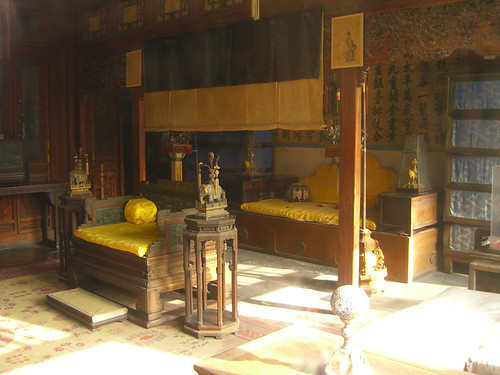
In a nutshell -- as the child emperor was too young to rule over the state, Cixi (as queen mother) effectively directed state matters. However, for the purpose of keeping up with appearances, she had to do so behind the curtain.
The imperial palace is marked by the 'Outer Court' and the 'Inner Court'. The former was where the emperor and the court officials held their official business. The latter was where the living quarters of the royal family (court officials, I was told, had their residences located outside the palace, within the city). Leading in and out of the inner and outer courts are corridors like this one.

To get a sense of how wide the corridors are, try spotting the three tourists in the picture.
What was it like back then? Were corridors like this bustling with activity, with court and palace officials hurrying about? Did soldiers patrol the place? Or was it deserted, cold and forbidding?
***
Everything in the Imperial Garden looked brown, bare and grey to me (it's winter!)
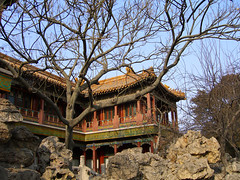
We saw these old gnarly trees, some of which sported coloured metal tags. The different coloured tags denoted the age of the trees. I think they ranged from 100 to 300 years old, if I remember correctly.
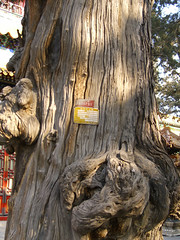
We made our way out by passing through the "Gate of Divine Prowess/ Might":
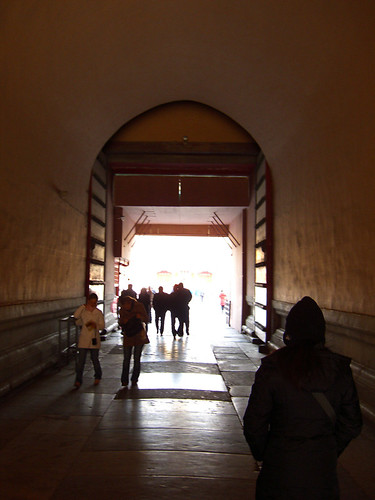
I thought I'd see the streets after passing through the north gate but there's still a long stretch. There's a mountain in the distance.

I mentioned in the previous post how the design of the palace was based on geomancy principles. Generally, it was deemed as auspicious to have "mountains behind one's back", taken to mean "having strong support" or "strong backing". My own understanding is that with mountains at the back, it meant that the palace was protected from enemies' attacks from the rear. Whether it's science or superstition, something must be working right for the palace to still exist after 500 years.
To the left and right of where we walked was the moat.
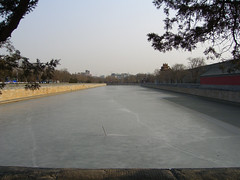
Walking out, my mind was still filled with a sense of the ancient. Meeting the first road upon exiting the Forbidden City, I tried to picture horses and carts instead of fuel-powered vehicles.
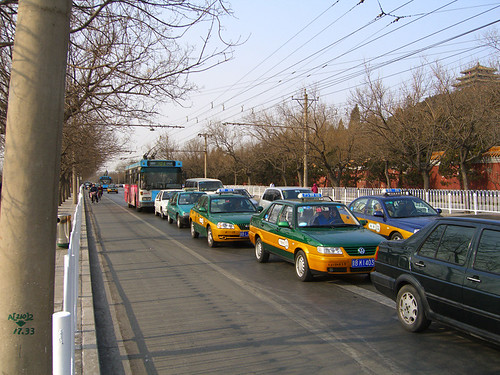
The road was not too congested on a Saturday afternoon. I'd expected more bicycles on the road. The tour guide said generally there were less cyclists because (1) it was winter, and (2) Beijing has grown so much over the years that it's become impractical to cycle long distances.
Next: Climbing the Great Wall at Juyong Guan

Very nice series of posts on your holiday in Beijing. It does help to capture those significant moments of learning, introspection and wanderlust doesn't it? Beijing is a culturally rich and historically significant city, and it awes me how much it has gone through over the last 100 years or so.
ReplyDeleteI must visit Beijing one day, inspired by your post!
Beijing isn't the most grand of cities in my opinion. But it's culturally significant, as you said. The city speaks for itself in that sense.
ReplyDelete